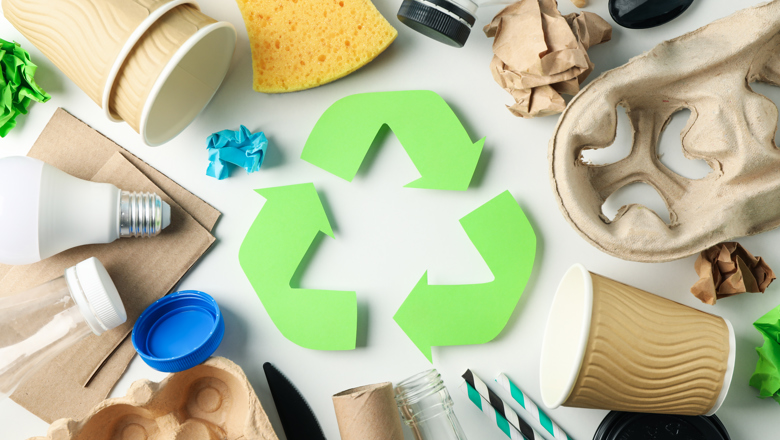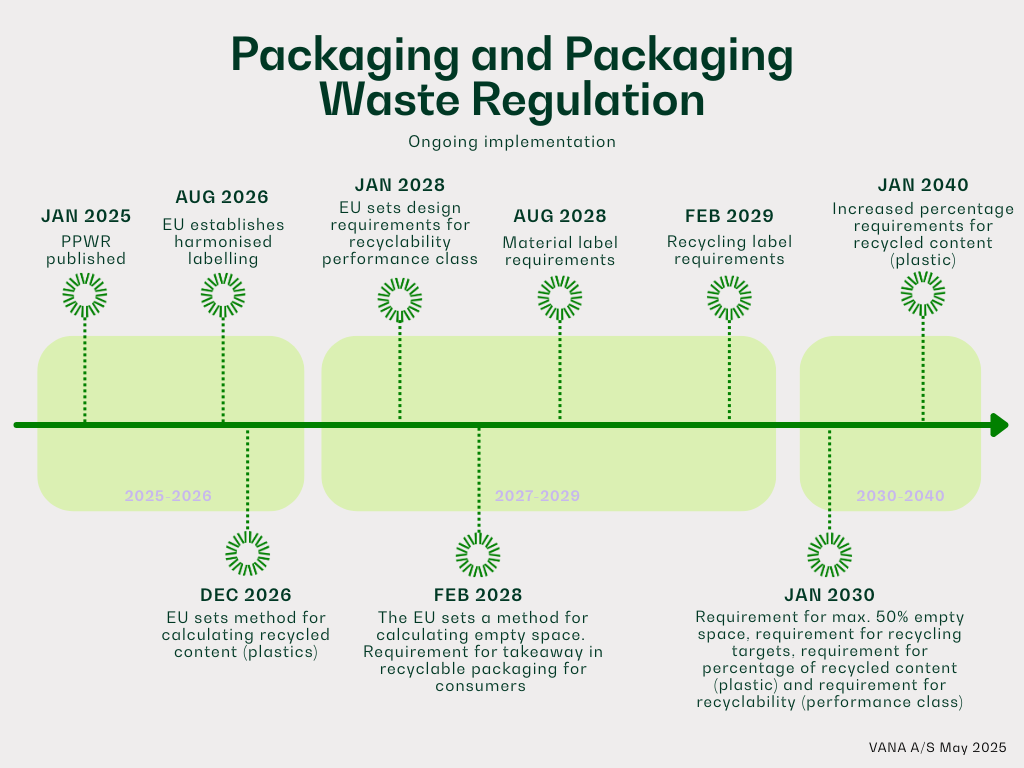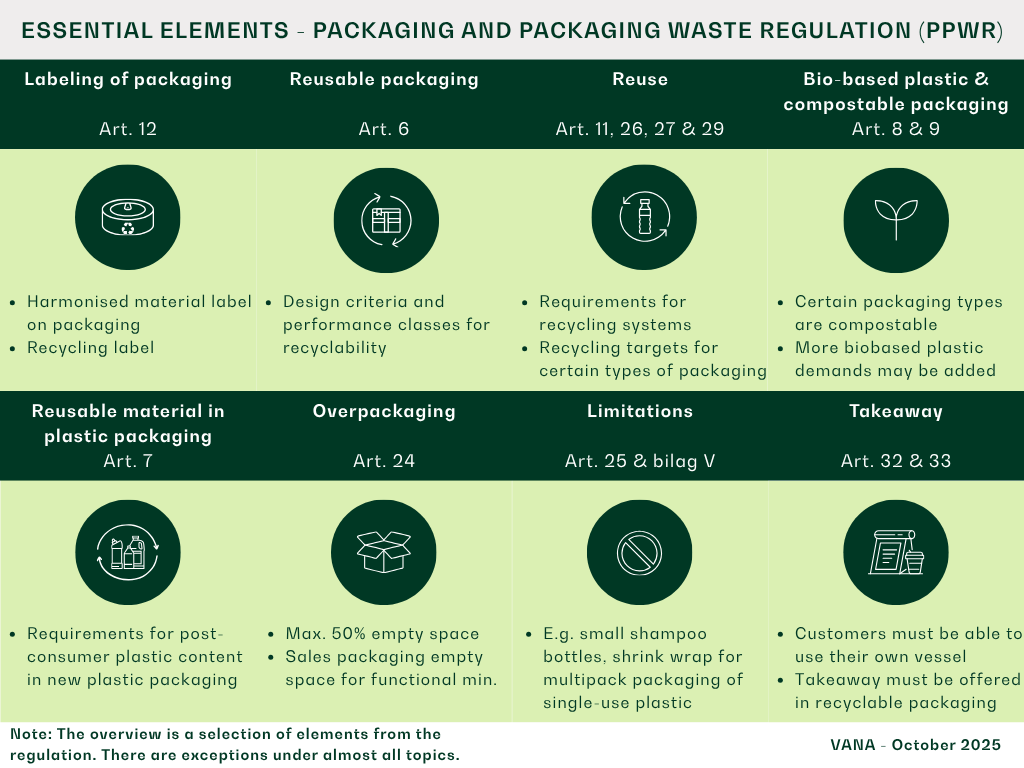The Packaging and Packaging Waste Regulation

A new Packaging and Packaging Waste Regulation has been finally approved in the EU as of January 2025. The regulation will apply from August 12, 2026.
The regulation will eventually repeal the existing packaging directive, which has been in place since the 1990s. The shift from a directive to a regulation means harmonisation of the packaging area across the EU. A significant aim is to reduce barriers to the free movement of goods between the 27 EU countries. The existing directive is currently administered differently in each country.

What are the main purposes of the regulation?
The extended producer responsibility on packaging is also part of the new regulation. The Danish statutory order on packaging has closely followed the creation of the new packaging and packaging waste regulation, ensuring harmonisation where possible. This applies, for instance, to the definition of the producer, which defines when a business is covered by the rules for extended producer responsibility.
The main purposes of the regulation are among other things to:
- reduce the quantity of packaging waste in the EU, which has only increased in recent years
- promote reuse and high-quality recycling
- introduce harmonised rules

Packaging must be provided with a harmonised label for material composition to facilitate sorting for consumers
- Based on pictograms and be easily understandable
- Exempt are transport packaging (unless it is e-commerce packaging), or packaging covered by deposit and return systems (provided with a clear label, which can be national and possibly colour-coded)
Reusable packaging must be provided with a label informing users that the packaging is reusable
- Additional information about reusability, reuse systems, etc., must be available through a QR code
- Reusable sales packaging must also be clearly identified and separated from one-way packaging at the point of sale
From 2030, only packaging that is recyclable may be placed on the market.
Recyclable packaging must:
- Be designed for material recycling, so that the resulting secondary raw materials can replace primary raw materials
- Be able to be collected and sorted separately without affecting the recycling of other waste streams
- Be able to be recycled on a large scale using current methods
Classification of the packaging's recyclability is done according to performance class A, B, or C.
From 2030, businesses that use reusable packaging must be connected to a recycling system with incentives and documentation.
Stores over 400 m² must strive to allocate 10% of the area to refill stations starting from 2030.
Reuse targets: A number of reuse targets aimed at particularly transport packaging, e-commerce, and beverages will be introduced from 2030 and increased in 2040.
Certain types of packaging (e.g. labels on fruits and vegetables) must be compostable under industrial conditions by February 12, 2028:
- Member states may require home compostability where relevant
- Other biodegradable materials must instead be designed for material recycling – not composting
- The Commission is developing harmonized EU standards for compostability and documentation
Biobased plastics will be reassessed by the Commission by 2028 – with the possibility of new requirements and targets for sustainability and use:
- Biobased materials may in certain cases replace recycled plastic – e.g. for food contact, where recycling technologies are insufficient
The content must be derived from plastic waste from the consumption stage, per packaging type and format as addressed in Annex II, Table 1, calculated as an average per factory and year.
Min. content as of January 1, 2030* / (January 1, 2040):
- 30 % / (50 %) for contact-sensitive packaging made of PET (except single-use plastic bottles for beverages)
- 10 % / (25 %) for contact-sensitive packaging made of other types of plastic than PET (except single-use plastic bottles)
- 30 % / (65 %) for single-use plastic bottles for beverages
- 35 % / (65 %) for other plastic packaging
- From 2030, all packaging must be designed with the least possible material and volume – without compromising on functionality or protection.
- Max. 50% empty space allowed in transport, grouped packaging, and e-commerce packaging.
- Traders who fill sales packaging must ensure that empty space is reduced to the minimum necessary to ensure the functionality of the packaging, including product protection.
Overpackaging is limited by:
- Unnecessary elements such as false bottoms, double walls, and extra layers are prohibited – with few exceptions (e.g., protected designs before 2025).
- Packaging must not appear larger than necessary to promote the perceived value of the product.
- Space filled with fillers such as bubble wrap, foam, etc. counts as empty space.
From January 1, 2030, selected single-use formats (cf. Appendix V) may no longer be put on the market, for example:
- One-way packaging in the accommodation sector intended for individual reservations
- Packaging for fruits and vegetables, mini-packages for hotels, etc.
- Single-use plastic packaging for flavorings, canned goods, sauces, coffee cream, sugar, and spices in the HORECA sector
- Grouped packaging of single-use plastic, for example: collateral film, shrink film
- Single-use plastic packaging, for example: trays, single-use plates and cups, bags, boxes
Micro-enterprises may be granted exemptions for certain formats due to technical impossibility.
- From February 12, 2027, takeaway companies must offer the option for refills in the customer's own container (applicable to both drinks and food)
- From February 12, 2028, companies must also offer reusable packaging as an alternative to single-use packaging – as part of a reuse system
- Consumers must be offered the same price and terms as when purchasing with single-use packaging
- Clear information at the point of sale must be provided about the possibility for refills and reusable packaging
- Micro-enterprises are exempt from the requirement for reuse offers
- From 2030, final distributors should strive for at least 10% of takeaway products to be offered in reusable packaging
Parts of the regulation are implemented through delegated acts that will specify the requirements. This is expected to lead to adjustments of the statutory order on packaging over the coming years.
Find the packaging and packaging waste regulation under relevant legislation

